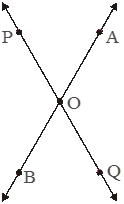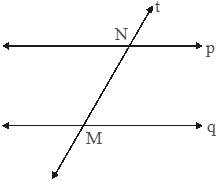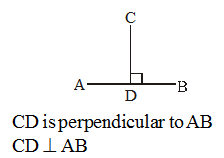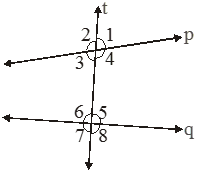- Books Name
- CBSE Class 7 Mathematics Book
- Publication
- Param Publication
- Course
- CBSE Class 7
- Subject
- Mathmatics
Pair of lines
1. Intersecting lines : Two lines are called intersecting lines if they have a common point. This common point is called the point of intersection.

AB and PQ is called the intersecting lines and O is called a point of intersection.
2. Transversal : A line that intersects two or more lines at distinct points is called a transversal.

In this fig. t is the transversal which cut two lines p and q at distinct points, ‘N’ and ‘M’ respectively.
3. Perpendicular lines:

Angles made by a transversal
Two lines p and q cut by a transversal t. It form angles that have some special names as :

(i) Exterior angles : The angles whose arms do not contain the segment on the transversal cut by the given lines are called exterior angles. Such as ∠1, ∠2 and ∠7 and ∠8
(ii) Interior angles : The angles whose one of the arms contains the segment on the transversal cut by the given lines are called interior angles. Such as ∠3, ∠4, ∠5 and ∠6
(iii) Corresponding angles : A pair of angles in which one arm of both the angles of the pair is on the same side of the transversal and the other arms are directed in the same sense is called a pair of corresponding angles. Such as ∠1 and ∠5, ∠4 and ∠8, ∠2 and∠6 and ∠3 and ∠7 are corresponding angles.
(iv) Alternate interior angles : A pair of angles in which one arm of each of the angles is on opposite sides of the transversal and whose other arm contains the segment on the transversal cut by the given lines is called a pair of alternate interior angles.
(v) Alternate exterior angles : A pair of angles in which one arm of each of the angles is on opposite sides of the transversal and whose other arm is directed in opposite sense doesnot contains the segment on the transversal cut by the given lines is called a pair of alternate exterior angles.

- Books Name
- class 7 Mathematics Book
- Publication
- ReginaTagebücher
- Course
- CBSE Class 7
- Subject
- Mathmatics
Transversal lines
Transversal: A line that intersects two or more lines at distinct points is called a transversal.
Transversal
A line that intersects two or more lines at different points is called a transversal.
Transversal of Parallel Lines
The lines on a plane that do not meet anywhere are called parallel lines.
Transversal of parallel lines give rise to quite interesting results.
Angles made by the transversal: There are different angles formed when the transversal cuts the lines. They are:
- Interior angles
- Exterior angles
- Pairs of Alternate interior angles
- Pairs of Alternate exterior angles
- Pairs of Corresponding angles
- Pairs of interior angles on the same side of the transversal
Transversal of Parallel Lines: We know that the parallel lines are the lines that do not meet anywhere. Transversals of parallel lines give rise to quite interesting results.
Checking for Parallel Lines
If a transversal cuts two lines, such that, each pair of corresponding angles are equal in measure.
Similarly, if a transversal cuts two lines, then each pair of the alternate interior angles are equal.
Also, if the transversal cuts the lines, then each pair of interior angles on the same side of the transversal are supplementary.

 Param Publication
Param Publication
 ReginaTagebücher
ReginaTagebücher
